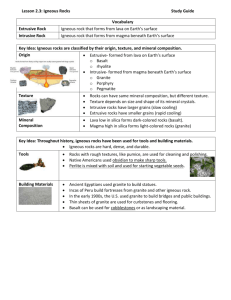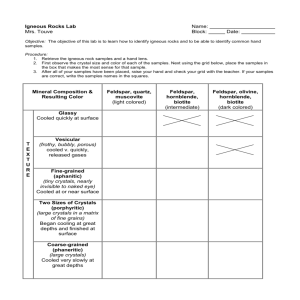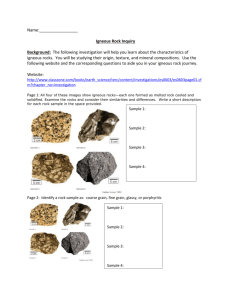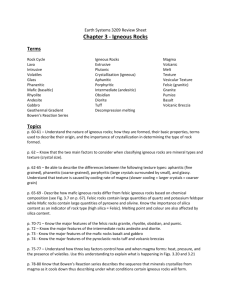Origin of Igneous Rocks The word igneous means "fire
advertisement
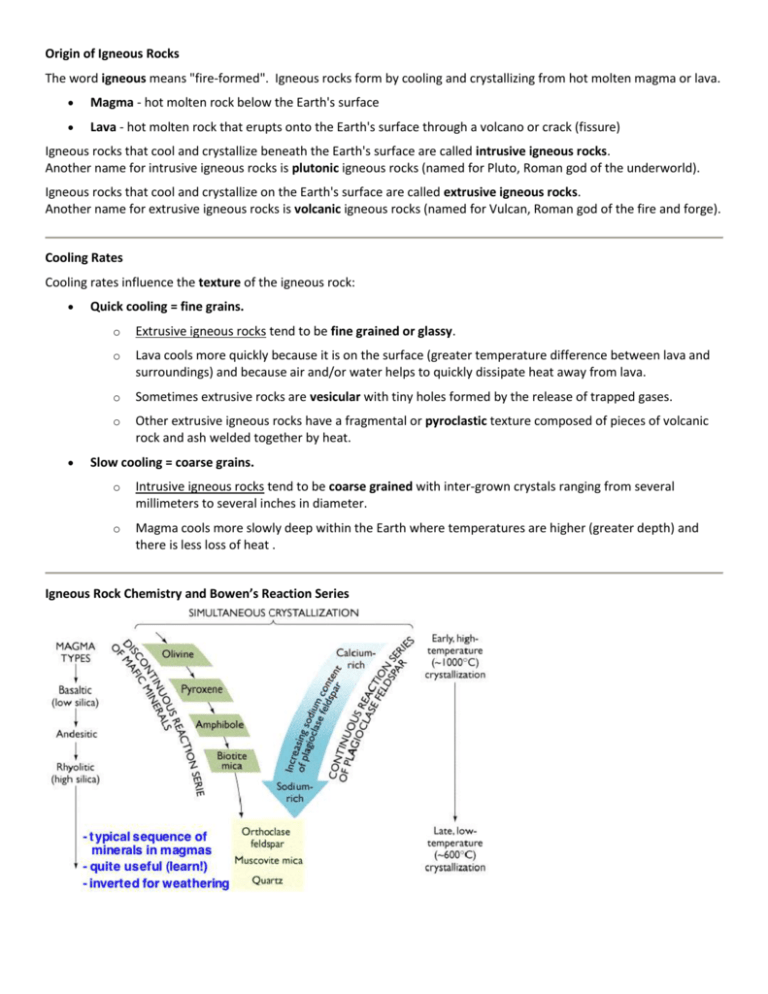
Origin of Igneous Rocks The word igneous means "fire-formed". Igneous rocks form by cooling and crystallizing from hot molten magma or lava. Magma - hot molten rock below the Earth's surface Lava - hot molten rock that erupts onto the Earth's surface through a volcano or crack (fissure) Igneous rocks that cool and crystallize beneath the Earth's surface are called intrusive igneous rocks. Another name for intrusive igneous rocks is plutonic igneous rocks (named for Pluto, Roman god of the underworld). Igneous rocks that cool and crystallize on the Earth's surface are called extrusive igneous rocks. Another name for extrusive igneous rocks is volcanic igneous rocks (named for Vulcan, Roman god of the fire and forge). Cooling Rates Cooling rates influence the texture of the igneous rock: Quick cooling = fine grains. o Extrusive igneous rocks tend to be fine grained or glassy. o Lava cools more quickly because it is on the surface (greater temperature difference between lava and surroundings) and because air and/or water helps to quickly dissipate heat away from lava. o Sometimes extrusive rocks are vesicular with tiny holes formed by the release of trapped gases. o Other extrusive igneous rocks have a fragmental or pyroclastic texture composed of pieces of volcanic rock and ash welded together by heat. Slow cooling = coarse grains. o Intrusive igneous rocks tend to be coarse grained with inter-grown crystals ranging from several millimeters to several inches in diameter. o Magma cools more slowly deep within the Earth where temperatures are higher (greater depth) and there is less loss of heat . Igneous Rock Chemistry and Bowen’s Reaction Series Igneous textures: Glassy - instantaneous cooling o Obsidian = volcanic glass Obsidian Aphanitic - fine grain size (< 1 mm); result of quick cooling at the surface. Rhyolite o Basalt o Rhyolite o Andesite Phaneritic - coarse grain size; visible grains (1-10 mm); result of slow cooling at depth. Granite - polished o Granite o Diorite o Gabbro Pegmatitic - very large crystals (many over 2 cm) o Granite pegmatite or pegmatitic granite Porphyritic- Mixture of grain sizes caused by mixed cooling history; slow cooling first, followed by a period of somewhat faster cooling. o o Terms for the textural components: Phenocrysts - the large crystals Groundmass or matrix - the finer crystals surrounding the large crystals. The groundmass may be either aphanitic or phaneritic. Types of porphyritic textures: Porphyritic-aphanitic Porphyritic-phaneritic o o Origin: mixed grain sizes and hence cooling rates, imply upward movement of magma from a deeper (hotter) location of extremely slow cooling, to either: a much shallower (cooler) location with fast cooling (porphyritic- aphanitic), or a somewhat shallower (slightly cooler) location with continued fairly slow cooling (porphyriticphaneritic). Rock name = porphyry Granite porphyry or porphyritic granite (porphyritic-phaneritic) - phenocrysts usually potassium feldspar Granite porphyry Andesite porphyry or porphyritic andesite (porphyritic-aphanitic) - phenocrysts usually hornblende (amphibole) Rhyolite porphyry or porphyritic rhyolite (porphyritic-aphanitic) Rhyolite Porphyry Vesicular - contains tiny holes called vesicles which formed due to gas bubbles in the lava or magma. Very porous. May resemble a sponge. Commonly low density; may float on water. o Vesicular basalt - basalt with a vesicles, which may be quite large. Sometimes lined with crystals to form geodes. Vesicular basalt Vesicular basalt with olivine phenocrysts, building stone at Hawaiian Volcano Observatory, Big Island of Hawaii o Pumice - light in color; white to gray; may be glassy or dull. Fully riddled with holes. Very sponge-like. Floats. Used as an abrasive. (Pumice stone, Lava Soap). Pumice Pumice o Scoria - dark in color; brown, black, or dark red; similar to vesicular basalt but is fully riddled with holes to form a spongy mass. (May find in barbecue grills as lava rock). Scoria Pyroclastic or Fragmental - pieces of rock and ash come out of a volcano and get welded together by heat. May resemble rhyolite or andesite, but close examination shows pieces of fine-grained rock fragments in it. May also resemble a sedimentary conglomerate or breccia, except that rock fragments are all fine-grained igneous or vesicular. o Tuff - made of volcanic ash o Volcanic breccia - contains fragments of fine-grained igneous rocks that are larger than ash. Pyroclastic rock Composition of Igneous Rocks Igneous rocks can be placed into four groups based on their chemical compositions: 1. Sialic (or granitic or felsic) 1. Dominated by silicon and aluminum (SiAl) 2. Usually light in color 3. Characteristic of continental crust 4. Forms a stiff (viscous) lava or magma 5. Rock types include: 1. Granite Granite 2. Rhyolite Rhyolite 6. Minerals commonly present include: 1. potassium feldspar (generally pink or white) 2. Na-plagioclase feldspar (generally white) 3. quartz (generally gray or colorless) 4. biotite 5. amphibole? 6. muscovite? 2. Intermediate (or andesitic) 1. Intermediate in composition between sialic and mafic 2. Rock types include: 1. Andesite (aphanitic) 2. Diorite (phaneritic) Diorite 3. Minerals commonly present include: 1. plagioclase feldspar 2. amphibole 3. pyroxene 4. biotite 5. quartz 3. Mafic (or basaltic) 1. Contains abundant ferromagnesian minerals (magnesium and iron silicates) 2. Usually dark in color (dark gray to black) 3. Characteristic of Earth's oceanic crust, Hawaiian volcanoes 4. Forms a runny (low viscosity) lava 5. Also found on the Moon, Mars, and Venus 6. Rock types include: 1. Basalt (aphanitic) Basalt 2. Gabbro (phaneritic) Gabbro 3. Diabase - texture intermediate between basalt and gabbro; characteristic of Early Mesozoic dikes in eastern North America. 7. Minerals commonly present include: 1. Ca-plagioclase feldspar 2. pyroxene 3. olivine 4. amphibole 4. Ultramafic 1. Almost entirely magnesium and iron silicates (ferromagnesian minerals) 2. Rarely observed on the Earth's surface 3. Believed to be major constituent of Earth's mantle 4. Commonly found as xenoliths in basaltic lavas 5. Rock types include: 1. Peridotite (phaneritic) 1. dominated by olivine - the birthstone is Peridot, which gives its name to Peridotite Peridotite 6. Minerals commonly present include: 1. Olivine is dominant. (Olivine is olive green). 2. may have minor amounts of pyroxene and Ca-plagioclase Classification of Igneous Rocks: Igneous rocks are classified or named on the basis of their texture and their composition. Igneous rocks cannot be classified by their process of formation, because the processes are interpreted from the rocks. Classification of rocks is always based on objective, observable, measurable data (such as grain size and the percentages of various minerals), and not on interpretations. The igneous rocks classification diagram below shows varying percentages of minerals in each of the four major categories of igneous rocks (sialic, intermediate, mafic and ultramafic). The table below shows the rock names for the various textures, combined with the mineral information. Texture Aphanitic Rhyolite Andesite Basalt -- Phaneritic Granite Diorite Diabase Gabbro Periodotite Pegmatitic Granite Pegmatite Diorite Pegmatite Gabbro Pegmatite -- Porphyritic Aphanitic Phaneritic Porphyritic Rhyolite Porphyritic Granite Porphyritic Andesite Porphyritic Diorite Porphyritic Basalt Porphyritic Gabbro Porphyritic Periodotite -- Vesicular Pumice Pumice Vesicular Basalt & Scoria Glassy Obsidian -- -- -- Fragmental Tuff (ash) Volcanic Breccia Tuff (ash) Volcanic Breccia -- -- COLOR INDEX (% Dark Minerals) 0 - 15 20 - 40 50 - 60 95 - 100

